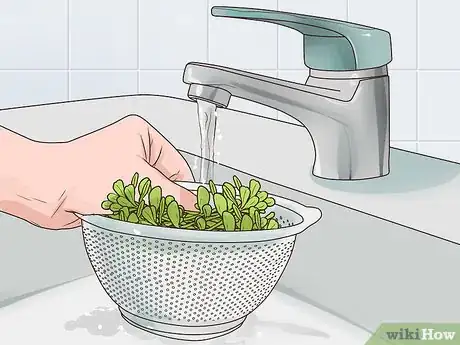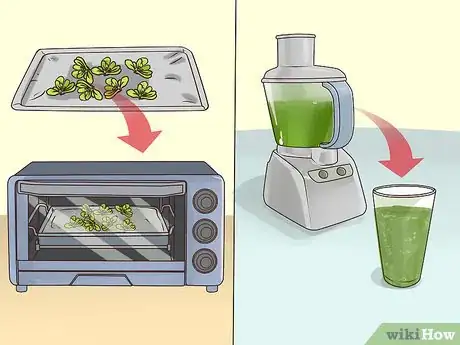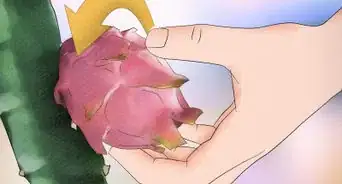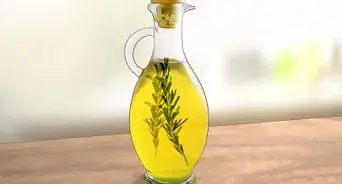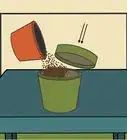This article was co-authored by Lauren Kurtz. Lauren Kurtz is a Naturalist and Horticultural Specialist. Lauren has worked for Aurora, Colorado managing the Water-Wise Garden at Aurora Municipal Center for the Water Conservation Department. She earned a BA in Environmental and Sustainability Studies from Western Michigan University in 2014.
There are 10 references cited in this article, which can be found at the bottom of the page.
wikiHow marks an article as reader-approved once it receives enough positive feedback. In this case, 94% of readers who voted found the article helpful, earning it our reader-approved status.
This article has been viewed 23,065 times.
Although common purslane is considered a weed in the United States, it is eaten throughout Europe, India, and the Middle East.[1] The leaves on purslane can be used in salads or dried to make herbs. You can find this plant growing in backyards and the cracks of city sidewalks. Forage for purslane by locating it in nature, identifying it, and cutting it with a pair of scissors. Grow and harvest purslane in your garden by choosing a suitable planting area and scattering seeds. Store unwashed purslane in your refrigerator or keep it in your freezer for up to a year.
Steps
Foraging for Purslane
-
1Hunt for purslane in sunny locations with loose, well-drained soil.[2] Purslane is a resilient plant that can crop up in many locations. It prefers full sun and soil that drains well. Check planter boxes, raised flower beds, cracks in cement work, and the edges of lawns for purslane.[3]
- Purslane begins growing after the last frost of the season. Look for purslane four to six weeks after the first frost in spring or anytime during summer.[4]
-
2Identify purslane. The stalks of this plant are oval and red in color. Plants often reach up to 12 in (30.5 cm) long. The leaves are succulent, shiny, smooth, and paddle shaped. When in the sunlight, you may see small yellow flowers on this plant. Each flower should have five petals.[5]
- All parts of common purslane are edible. However, all foraged greens should be washed thoroughly in cold water before being eaten.
Advertisement -
3Squeeze the stem to check for a milky sap. Purslane is similar in appearance to a poisonous plant called the Hairy-Stemmed Spurge. Verify that potential purslane isn’t this poisonous plant by breaking its stem and squeezing it with your fingers. If the plant produces a milky sap, it is poisonous and should not be eaten.[6]
-
4Cut purslane with scissors or shears. Wild purslane should be snipped close to the base of the stem. Hold the tip of the purslane with your hand to improve your access to its base and cut the stem. Harvest purslane in this fashion until you’ve collected as much as you desire or have exhausted the plant.
- Harvesting purslane earlier in the day will result in a stronger lemony flavor in the plant. The intensity of this flavor decreases with later harvesting times.[7]
- The leaves of purslane are ideal for harvest when young. Young leaves are flexible and have a slight shine.[8]
- As you cut the purslane, remove dead leaves, dirt, twigs, and other debris from the plants to make cleaning them easier later.[9]
Growing Purslane
-
1Purchase purslane seeds. These can be bought at many flower shops, nurseries, home and garden centers, and most greenhouses. Two common varieties suitable for a home garden include golden purslane (Portulaca sativa) and garden purslane (Portulaca oleracea).[10] Store seeds in a cool, dry, dark location while waiting to plant.[11]
-
2Choose a suitable patch of soil for planting. Your purslane will thrive in full sunlight and porous soil. If these conditions are unavailable, make a planter box and fill it with potting soil. Position the planter so it receives at least eight hours of sunlight.[12]
-
3Plant purslane in spring or summer. Purslane should be planted in spring when there is no longer any risk of frost or at any point in summer. Scatter the purslane seeds over your planting area. Drag a garden rake lightly over the soil after scattering the seeds. Tamp the soil lightly with a shovel or a similar garden tool.[13]
- As long as you allow a few plants to mature to adulthood and seed, your purslane crop will continue to grow every year.
- Purslane generally takes about four to six weeks before it is ready to harvest. In ideal conditions, your purslane may be ready to harvest even sooner.[14]
-
4Water purslane in arid climates, heatwaves, and droughts. Purslane requires very little in the way of care once it is planted. In dry conditions, however, you should water the plants enough to keep the soil from drying out.[15]
-
5Manage purslane size with frequent harvesting. Purslane can get out of hand quickly if left to its own devices. Harvest your purslane regularly to keep it manageable. Cut purslane with scissors or garden shears at the base of its stalk when harvesting.[16]
Storing Purslane
-
1Keep unwashed purslane in your refrigerator. After your purslane is harvested, put it in a plastic bag and insert it into your refrigerator. This will keep the purslane good for about a week. Be sure to wash the plant before eating, especially if it has been foraged.
- If a refrigerator is unavailable, store the purslane in a cooler bag or similar container. This will keep the purslane fresh for several days.[17]
-
2Clean the purslane thoroughly before eating. Transfer harvested purslane to a colander. Rinse the plant under a stream of clean, cold water. Shake excess moisture from the cleaned purslane, pat it dry with paper towel or a clean dishcloth, and it’s ready to eat.[18]
- While rinsing, use your clean hands to spread the leaves to ensure bugs and dirt have been removed.
-
3Store cleaned purslane in a freezer for up to a year. When the purslane is clean and completely dry, put it in a freezer bag. Excess moisture may cause freezer burn or worsen the quality of purslane once it is thawed. Write the date on the bag, store it in your freezer, and use it within a year.[19]
-
4Dry purslane and use it in smoothies. Once your purslane is clean, remove the leaves from the stems and spread the leaves in a thin layer on a baking sheet. Set your oven to its lowest setting and insert the sheet. When the purslane becomes brittle, it's finished.
- Keep a close eye on purslane while in the oven to prevent it from burning. Handle the hot baking sheet with an oven mitt or potholder when removing it from the oven.
- Dried purslane can be kept as whole leaves, crushed, or powdered. To crush or powder the leaves, pulse them on a low setting with a blender or food processor until the desired fineness is achieved.
- You can add purslane to smoothies or sprinkle it in with other recipes to add some extra nutritional value. Powdered purslane can also be used as a thickener.[20]
Community Q&A
-
QuestionAfter cutting purslane, will more edible leaves grow on the remaining plant?
 Mark O'GuinCommunity AnswerUsually. If the plant has enough vigor and remaining foliage, it will continue to grow and produce more leaves.
Mark O'GuinCommunity AnswerUsually. If the plant has enough vigor and remaining foliage, it will continue to grow and produce more leaves. -
QuestionCan we dry purslane in the sun?
 Mark O'GuinCommunity AnswerSure! However, it is a succulent, fleshy leaf, delicious freshly served. I don't think it would be as enjoyable to consume rehydrated after drying.
Mark O'GuinCommunity AnswerSure! However, it is a succulent, fleshy leaf, delicious freshly served. I don't think it would be as enjoyable to consume rehydrated after drying.
Things You’ll Need
Foraging for Purslane
- Container (optional; for holding harvested purslane)
- Gloves (optional)
- Scissors (or garden shears)
Growing Purslane
- Gloves (optional)
- Purslane seeds
- Rake
- Scissors (or garden shears)
- Shovel
Warnings
- Eating unwashed plants, especially those that have been foraged, can be harmful to your health. Always rinse greens before eating them.⧼thumbs_response⧽
- Inspect purslane carefully when harvesting it. The Hairy-Stemmed Spurge is similar in appearance to purslane but is poisonous.⧼thumbs_response⧽
References
- ↑ http://ipm.ucanr.edu/PMG/PESTNOTES/pn7461.html
- ↑ http://wildfoodshomegarden.com/Purslane.html
- ↑ http://www.seriouseats.com/2013/08/foraged-flavor-all-about-purslane.html
- ↑ http://ipm.ucanr.edu/PMG/PESTNOTES/pn7461.html
- ↑ http://ipm.ucanr.edu/PMG/PESTNOTES/pn7461.html
- ↑ http://www.ediblewildfood.com/poisonous-plants.aspx#spurge
- ↑ http://wildfoodshomegarden.com/Purslane.html
- ↑ http://www.seriouseats.com/2013/08/foraged-flavor-all-about-purslane.html
- ↑ https://www.youtube.com/watch?v=wuL9c7gyw9k
- ↑ http://www.weekendgardener.net/blog/2013/09/learn-to-grow-purslane.htm
- ↑ http://www.backdoorsurvival.com/8-tips-for-storing-seeds-for-the-long-term/
- ↑ http://wildfoodshomegarden.com/Purslane.html
- ↑ http://wildfoodshomegarden.com/Purslane.html
- ↑ http://www.weekendgardener.net/blog/2013/09/learn-to-grow-purslane.htm
- ↑ http://wssa.net/wp-content/themes/WSSA/WorldOfWeeds/purslane.html
- ↑ https://www.youtube.com/watch?v=wuL9c7gyw9k
- ↑ http://www.seriouseats.com/2013/08/foraged-flavor-all-about-purslane.html
- ↑ http://www.npr.org/templates/story/story.php?storyId=6104414
- ↑ https://www.youtube.com/watch?v=wuL9c7gyw9k
- ↑ https://www.newlifeonahomestead.com/how-to-dry-purslane/










